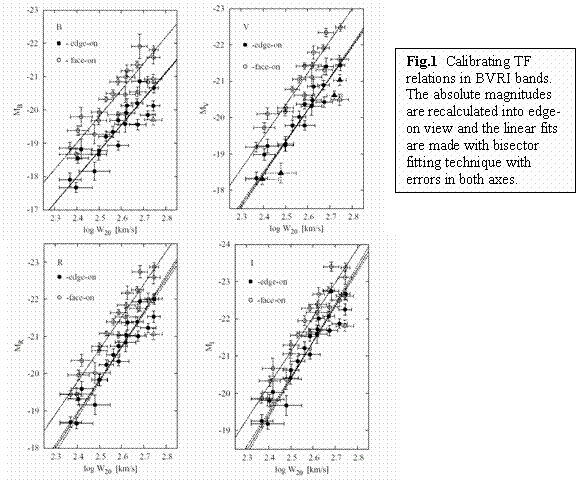TULLY-FISHER
RELATION
The TF relation is one of the
most important tools in
extragalactic distance estimation, and is probably the best for spiral
galaxies
at distances beyond our Local Group. This importance is demonstrated by
the
fact that it is the focus of a Hubble Space Telescope Key Project
(Sakai et
al., 2000). With the HST`s resolution it is possible to identify
Cepheid
variables in a larger number of nearby galaxies than was previously
possible,
and in particular galaxies which can be used with the TF relation. This
enables
a direct calibration of the TF relation, and drastically reduces the
number of
steps, and hence the uncertainty, in the extragalactic distance scale.
One
of the most detailed investigations of the empirical TF relation is
that of
Verheijen (1997, hereafter V97), who obtained B, R, I, and K band
photometry,
as well as detailed H I synthesis observations of a complete sample of
(bright)
spiral galaxies in the Ursa Major cluster (see also Tully et al. 1996).
V97
made a detailed comparison of different TF relations using different
photometric bands and different velocity measures. This study has
yielded a
number of important results: (i) the scatter in the TF relation is
smallest
when using the Nat part of the H I rotation curve, Vflat,
as velocity measure; (ii) when using the H I line
widths, the TF relations become shallower and harbor a larger scatter;
(iii)
the results of Sprayberry et al. (1995) and Zwaan et al. (1995), that
high
surface brightness (HSB) and low surface brightness (LSB) spirals
follow the
same TF relation, are confirmed; (iv) both the scatter and the slope of
the TF
relation are extremely sensitive to selection criteria ; and (v) the
slope of
the TF relation changes from b = -6.7
in the B band to -10.5 in the K band.
In the context of galaxy scaling
relation, the TF
relation is a plane of the Fundamental Plane for the spiral galaxies.
This
relation is a combination of at least three independent relations:
- A relation between the amount of
luminous matter and the circular velocity, which is the outcome of the
process of galaxy formation.
- A relation between the
luminosity and the luminous mass, which is the result of the history of
star formation.
There must, of course, also be a
connection between the distribution of luminous matter and that of all
matter,
that is, luminous plus dark.
OUR RESEARCH
Our
research is concerned in application of one of the famous scaling
relation for
spiral galaxies, namely the TF relation. We focused in making an
adequate
calibration of TF relation for distance determination to edge-on spiral
galaxies.
First
of all, we need from one calibration sample and other target sample of
spirals,
which is homogeneous with respect to the inclination angle i~90° (only edge-on galaxies). The
BVRI
magnitude data for the calibration sample are taken from Macri et al.
(2000),
and the edge-on target samples are in fact three: 63 spirals from
Pohlen
(2001), 37 southern spirals from de Grijs (1998), and 120 spirals from
Karachentsev et al. (1992).
In
order to determine the distances to the galaxies in these edge-on
samples, we
have made recalculation of the absolute magnitudes of the calibrators
into
edge-on view. It is known from the literature that usually this is made
in
face-on view through the internal extinction correction.
Here
we present the first set of TF calibration equations in BVRI bands,
determined
using the internal extinction model of Nedialkov (1998) and
recalculating the
edge-on magnitudes:

There
are several important points in our work:
- To study the effects of internal
extinction correction models upon the calibration of the TF relation
and respective distance determination to the target edge-on galaxies.
- To investigate the influence of
the value variations of the geometrical parameters of galaxies (q0, a/b) over the TF
parameters for the calibration.
- To check for the consistency of
the diameter TF relation for distance determination to edge-on spiral
galaxies.
- To estimate the Hubble parameter
by means of calibration of the TF relation in order to improve that the
edge-on galaxies can be successfully used for TF distance determination
(without making any complex corrections for Malmquist like selective
effects).
In
order to achieve results for each of these points, we were made several
tests
with variation of the parameters and internal extinction models, which
enter
into the general scheme of the TF calibration (see Stanchev et al.
2005, in
preparation). We included two internal extinction models for the
calibrators:
the first is according to Tully et al. (1998), in which the rotational
parameter from radio observations is taken into account, and this
according
Nedialkov (1998). For each model are made several calculations of the
absolute
magnitude of the calibrator galaxy varying the geometrical parameter
included
in the equations of the models. The final results for the determined
distances
are compared through the constructed Hubble diagrams.
The
diameter TF relation is calibrated in B and I-bands. The data are taken
from Macri
et al. (2000) for the I-band, and from LEDA database for the B-band
diameters.
The absolute diameters are corrected for internal extinction and
recalculated
into edge-on view as well (see Stanchev et al. 2005).
The
summarized results are as follows:
- The calibration of the edge-on
magnitude TF relation do not increase the TF dispersion and can be
successfully applied for distance determination to edge-on samples of
spiral galaxies (see Stanchev et al. 2004). The obtained TF dispersion
are consistent with other published results (Sakai et al. 2000; Tully
& Pierce 2000)
- The choice of internal
extinction model for the TF calibration is important point, which
influences the final results of distance determination. The variations
between edge-on and face-on absolute magnitudes of the calibrator
galaxy results in magnitude offset around 1mag in
calibrating TF relation. For instance the differences between the
edge-on galaxy magnitudes and the magnitudes, corresponding to
arbitrary inclination angles are 0.82mag for B band and
this value is reduced to 0.55mag in I band.
- Our
results follow the established trend of increment of the TF dispersion
toward the shorter wavelengths. The increment of the TF slope with the
growth of wavelength is confirmed as well.
- Some combinations of the
internal extinction model and variations of the geometrical parameters
gives acceptable value of the Hubble parameter, which is consistent
with the recently estimations of H0.


Fig.2
Hubble diagram for the edge-on galaxies from Pohlen (2000). On the same
diagram are plotted two estimations of the Hubble parameter, obtained
through TF calibration with Tully et al. (1998) internal extinction
model and variations of the intrinsic axial ratio q0
according Sakai et al. (2000) and Haynes and Giovanelli.
REFERENCES
Karachentsev
I.D.,
Georgiev Ts.B., Kajsin S.S., Kopylov A.I., Ryadchenko V.P. and Shergin
V.S.,
A&A Transactions, 1992, 2, 256
Macri L. M., Huchra J. P.,
Pohlen, M.,
Ph.D. Thesis,
Sprayberry, D., Bernstein, G.
M., Impey, C. D., & Bothun, G. D.
1995, ApJ, 438, 72
Stanchev O. I., Nedialkov P.,
Georgiev Ts., Comptes rendus de l`Academie bulgare des Sciences, Tome 57, No 6, 2004; astro-ph
/ 0412324
Stanchev O. I., Nedialkov P.,
Georgiev Ts., Astrophys.
Space Sci., 2005, in
preparation
Stanchev, O.I., Nedialkov, P.L.,
Georgiev, Ts.,
and Georgiev,
Verheijen, M. A. W. 1997, Ph.D.
thesis, Univ. Groningen
(V97)
Zwaan, M. A., van der Hulst, J. M.,
de Blok, W. J.
G., & McGaugh, S. S., 1995, MNRAS, 273, L35